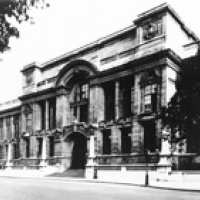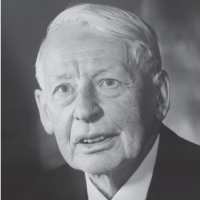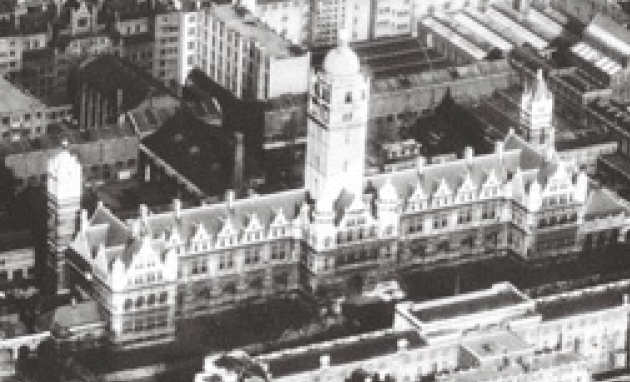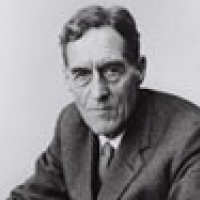The Physics Department
 The Royal College of Science, built in 1906, housed the Chemistry & Physics Departments. From 1906 to 1932 Callender was head of the Physics Dept. He was famous for his work on the properties of steam.
The Royal College of Science, built in 1906, housed the Chemistry & Physics Departments. From 1906 to 1932 Callender was head of the Physics Dept. He was famous for his work on the properties of steam.
G P Thomson replaced Callender in 1932. Thomson was a Nobel Laureate for his discovery of electron diffraction by crystals (and other substances) which meant that the electron’s motion could be described by the mathematics of wave mechanics. His father, J J Thomson, was also a Nobel Laureate for work on electrons as particles where the motion could (in the circumstances of his investigations) be described by Newtonian mechanics .
G P Thomson, during his Physics Dept. headship, initially established an electron diffraction group. Subsequently he became involved in other spheres particularly nuclear energy after the German discovery of the production of neutrons in uranium (U235) related to the fission process. Later he became interested in the nuclear fusion process and in 1946, with M. Blackman, took out a patent for a fusion machine.

G P Thomson was (until he retired, to become master of Corpus Christi College, Cambridge) virtually the only Professor in the Physics Dept. He arranged to do work on uranium to investigate the
Throughout his leadership of the Physics Dept. his interest in electron diffraction continued. possible neutron chain reaction. This was in the early 1940s, but subsequently this was stopped and the work on uranium became secret and it ended at Imperial College.
The RCS building was outwardly symmetrical, with the Chemistry side (towards Exhibition Road) and the Physics side (towards Queens Gate). The building stood on the south side of the Imperial Institute Road – an ordinary through-road for traffic between Queens Gate and Exhibition Road. The Imperial Institute building faced the north side of the RCS building with what is now known as the Queens Tower facing the entrance of the RCS building. The Imperial Institute Building was also symmetrical about the Queens Tower with two smaller towers at each end of the building. The Imperial Institute was a museum demonstrating various aspects of the Empire. There was a free cinema together with other amenities. There was (and probably still is) a tunnel running from the vicinity of the Queens Tower to College’s Beit Building between Kensington Gore and Prince Consort Road. The tunnel emerged somewhere in the vicinity of the ground on which the new Physics building was to be erected as a first class steel frame building. The tunnel was very useful to avoid the rain.
 The new Physics building was started sometime in the 1950s coinciding with P. M. S. Blackett arriving as the new head of the Physics Dept. around 1953. Physics continued in the new “old” RCS building till the completion of the new Physics building in 1960 when removal from the old RCS building to the new Physics building took place. The new Physics building subsequently became the Blackett Laboratory.
The new Physics building was started sometime in the 1950s coinciding with P. M. S. Blackett arriving as the new head of the Physics Dept. around 1953. Physics continued in the new “old” RCS building till the completion of the new Physics building in 1960 when removal from the old RCS building to the new Physics building took place. The new Physics building subsequently became the Blackett Laboratory.
Blackett (Cambridge, Birkbeck, Manchester and finally Imperial) instituted a professor in charge of each group. This meant a change from a single overall professor to perhaps around 8 “new” professors. He was instrumental in ensuring the provision of a “common room” on level 8 of the new building as well as having a say in the design of other parts of the new Physics building.
He was involved with the Wilson Labour Government as scientific advisor. He was awarded the OM (presumably on the advice of Harold Wilson). After Blackett’s death Wilson gave a memorial lecture for him in the large physics lecture room in the new building, 1975. During Blackett’s time at Imperial he became President of the Royal Society and his final accolade was a Life Peerage.
 Blackett’s handling of the Staff Meetings was unique for its brevity. He spent the last years of his retirement working on magnetism in the in the Dept. He had a long interest in terrestial magnetism linked, in some way, with continental drift.
Blackett’s handling of the Staff Meetings was unique for its brevity. He spent the last years of his retirement working on magnetism in the in the Dept. He had a long interest in terrestial magnetism linked, in some way, with continental drift.
After Blackett’s retirement from the Departmental headship he was replaced by Butler, the first of the system of rotating “heads” each one for a period of about 5 years. The Rector effectively appointed each new head.
During the 1930s Richard Beeching was first an undergraduate under GP Thomson and was awarded his PhD in 1936. After a brief time as a demonstrator, Beeching left to eventually obtain a high place with ICI. The Conservative government 1963 persuaded him to improve the condition of the railway. As a result about 20% of the system was shut down. He later became a life peer.
Written by Dr N D Lisgarten